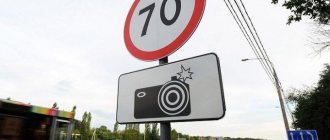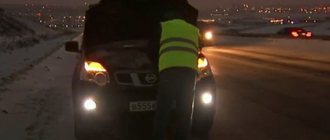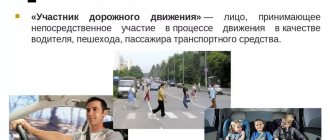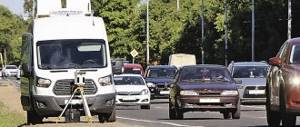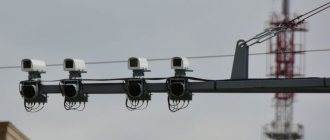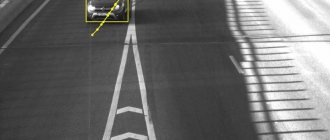How do video cameras work to record violations?
Today there are a great variety of camera types. They are classified not only by model, but also by readability range, mobility, types of violation, etc. Let's look at some of them.
Complexes (systems) for automatic video recording of traffic violations:
Arena. It can be both stationary and mobile. Its readable speed range is from 20 to 250 km/h. The control zone from where the camera detects the intruder is 8 meters and up to 10 meters wide. The photograph is of high quality and contains information; photo of transport, time and date, as well as speed. It can also work in the dark.
Spark. It consists of a speed meter, monitor, camera and remote control. It is attached directly to the patrol car and works while the car is moving or parked. It is used to document and confirm facts of violation of traffic rules. Its measurement range is up to 800 meters. Speed range from 20 to 240 km/h. The data storage time is 10 minutes.
Radars for detecting violations:
Visir. This is a miracle radar that not only records speed, but also takes photos/videos of the violation. The control zone is at least 400 meters. Works in both stationary and mobile modes. In addition to the car, the photo will indicate the date, time and speed of the vehicle.
Chris-1. Automatic range camera. It controls speed and recognizes license plates. The range of measured speed is from 20 to 240 km/h. Works only on well-lit areas of the road. One sensor can only detect one lane. Its peculiarity is that it creates a database of repeated violations, and also prepares “chain letters” automatically.
Rapier. It is installed, as a rule, in areas remote from traffic police posts, on highways where there is a high probability of accidents. The readable speed range is from 20 to 250 km/h. Having recorded the car's license plates, the camera automatically searches for it in the database. Records many different violations. In addition, it can remotely control traffic lights and barriers to delay traffic or regulate traffic flow on a busy highway.
These are not all cameras, we have listed only the main ones that are most often used in Russia.
Information from cameras flows to the Center for Automated Recording of Administrative Offences. Data about violators first undergoes initial automatic processing, and operators check the information on the computer and send it to the traffic police server, where it is checked against the database. After this, the computer automatically draws up a resolution on an administrative violation, and the inspector, within ten days from the date of the violation, sends a letter with a protocol to the car owner, in which a photo of the administrative violation is attached. If the car was driven by someone else by proxy, the owner of the car can appeal the decision in court. The current legislation establishes the following deadlines: 10 days to appeal a decision on an administrative offense and 60 days to pay a fine.
A complaint against a decision in a case of an administrative offense may be filed within ten days from the date of delivery or receipt of a copy of the decision.
Part of Article 30.3 of the Code of Administrative Offenses of the Russian Federation
An administrative fine must be paid in full by a person held administratively liable no later than sixty days from the date of entry into force of the decision to impose an administrative fine, except for the cases provided for in parts 1.1, 1.3 and 1.4 of this article, or from the date of expiration deferment or installment period provided for in Article 31.5 of this Code.
Part 1 of Article 32.2 of the Code of Administrative Offenses of the Russian Federation
Please note that the payment deadline will only begin to count after the appeal period has expired.
Crossing the stop line
In 2021, complexes appeared that can be used to capture driving along a stop line. If we are talking about an intersection, then even crossing it with only the first two wheels will be enough to get it. This point is regulated by the second part of Article 12.12 of the Code of Administrative Offenses of the Russian Federation. The fine for this is 800 rubles. with a possible fifty percent discount.
If a special road sign is installed in front of the stop line, then the violator will have to pay less - 500 rubles. When paying a fine in the first 20 days, a 50% discount is also provided. This is indicated in the first part of Article 12.6 of the Code of Administrative Offenses of the Russian Federation.
Photo and video recording of traffic violations
Increasingly, drivers are interested in legal ways to record violations. There are several of them, and we will consider each of them in more detail.
First way. Violations are recorded using video recording, photography and filming, which operate exclusively in automatic mode. These are the same ill-fated cameras recording traffic violations. This is clearly stated in the Administrative Regulations of the Ministry of Internal Affairs of the Russian Federation dated March 2, 2009 No. 185.
75. The basis for monitoring road traffic using automatic fixation means is the decision of the head of the State Traffic Inspectorate unit of the territorial body of the Ministry of Internal Affairs of Russia at the regional level on the use of such technical means, the head of the traffic police unit, the head of the State Traffic Inspectorate unit of the territorial body of the Ministry of Internal Affairs of Russia at the regional level on the procedure for performing service employee.
77. When supervising road traffic using automatic fixation means, the following can be used: stationary automatic fixation means placed on road transport infrastructure structures (pillars, supports) and other structures; mobile means of automatic fixation, placed on special structures (tripods, tripods, towers based on vehicles); wearable automatic fixation devices designed to provide traffic control for a limited period of time and do not require special structures for placement; mobile automatic fixing devices designed to provide traffic surveillance for a limited period of time and placed on board vehicles.
78. Automatic fixing means are used for traffic supervision in accordance with established requirements. The choice of installation locations for automatic fixation devices is based on an analysis of accident rates on sections of highways with a high probability of accidents.
Clause 75, 77, 78 of the Order of the Ministry of Internal Affairs of Russia dated August 23, 2017 N 664)
It became possible to fine people based on video or photographic materials from July 1, 2008. Initially, there were a small number of devices of this type and they were all located in the center of the capital. Today, there are stationary radars in all regions of our country. Basically, they are “aimed” at violating the speed limit, driving into the oncoming lane, as well as driving along a dedicated lane. When recording traffic violations by these means, which are provided for by Chapter 12 of the Code of Administrative Offenses of the Russian Federation, a resolution on an Administrative Offense is issued without the participation of the person who committed the violation, and the rules for drawing up a resolution, which are provided for in Article 29.10 of the Code of Administrative Offenses of the Russian Federation, must be observed.
Second way. Recording violations using special technical means that are approved in the prescribed manner as measuring instruments, have the appropriate certificates and have passed metrological verification. They also work in automatic mode, but the difference between the previous tools and these is only that some are included in the section of special technical means, while others are not.
1. Special technical means mean measuring instruments that are approved in the prescribed manner as measuring instruments, have appropriate certificates and have passed metrological verification.
2. Testimony of special technical means is reflected in the protocol on an administrative offense or a resolution in a case of an administrative offense issued in the case provided for in Part 3 of Article 28.6 of this Code. (as amended by Federal Law No. 210-FZ dated July 24, 2007)
Article 26.8 of the Code of Administrative Offenses of the Russian Federation
Legal consultation
Get qualified help right now! Our lawyers will advise you on any issues out of turn!
To get a consultation
Third way. Recording violations using recordings from household photo/video cameras, as well as photo/video cameras of mobile phones. To understand whether devices operating in automatic mode include devices such as a video recorder, a camera, a mobile phone video camera, as well as other filming gadgets from the field of electronics, we decided to attach
, which explains everything down to the smallest detail. Based on this, we can conclude that recording by household means is evidence, but since it is subject to human factors, it will be considered in accordance with paragraph 3 of part 1 of Article 28.1 of the Code of Administrative Offenses of the Russian Federation.
1. The reasons for initiating a case of an administrative offense are:
3) messages and statements of individuals and legal entities, as well as messages in the media containing data indicating the existence of an administrative offense event (with the exception of administrative offenses provided for in Part 2 of Article 5.27 and Article 14.52 of this Code);
Article 28.1 of the Code of Administrative Offenses of the Russian Federation
However, this will not be conclusive evidence of your violation. You will need a really good car lawyer who can defend your interests in court.
Video recording of traffic violations. How to find out about the camera?
Previously, drivers did not know about the presence of cameras and drove without even suspecting that they would soon receive a “chain letter”. From July 1, 2013, roads must have a warning sign or special markings.
First, let's look at the sign. It belongs to the category “Signs of additional information”. The sign “Photo and video recording” of traffic violations has its own number in the traffic rules – 8.23
Applicable with signs 1.1, 1.2, 1.8, 1.22, 1.35, 3.1 - 3.7, 3.18.1, 3.18.2, 3.19, 3.20, 3.22, 3.24, 3.27 - 3.30, 5.1 - 5.4, 5.14, 5.21, 5.23.1 , 5.23 .2, 5.24.1, 5.24.2, 5.25 - 5.27, 5.31, 5.35 and 5.36, as well as with traffic lights. Indicates that in the coverage area of a road sign or on a given section of the road, administrative offenses can be recorded using automatic special technical means that have the functions of photography, filming and video recording, or by means of photography, filming and video recording.
Traffic rules sign 8.23
Its dimensions are determined by GOST R 51256-2018. National standard of the Russian Federation. Technical means of organizing traffic. Road markings. Classification. Technical requirements".
It is worth noting that using only a sign without road markings is not allowed, so I suggest going directly to it.
The markings also have their own standards established by GOST R 52289–2004 “Technical means of organizing traffic. Rules for the use of road signs, markings, traffic lights, road barriers and guide devices" and GOST R 52290–2004 "Technical means of organizing road traffic. Road signs. General technical requirements". In the traffic rules it is also assigned its own serial number - 1.24.4.
Various variations of the camera image inside the rectangle are allowed, but the dimensions of the triangle themselves are specified in GOST.
It is used to duplicate the additional information sign of plate 8.23 “Photo and video recording” and is applied in the same cross section of the road with sign 8.23. On multi-lane roads, markings 1.24.4 are applied on each lane, with the exception of cases when the fixation is carried out along a dedicated lane. It can be used independently, while marking 1.24.4 is applied outside the populated area at least 300 m, and in the populated area at least 100 m before the beginning of the road section on which fixation can be carried out, and then every 500 m throughout. If there are junctions or intersections, marking 1.24.4 is repeated after each intersection.
Traffic regulations road markings 1.24.4
Please note that the image on the road is slightly elongated. This is done so that while driving the image appears to the driver in normal proportions.
Traffic police inspectors are confident that if citizen motorists see a warning that a few meters away there is video or photographic recording of traffic violations, then he will definitely slow down. In fact, the speed will be reduced, but only within the camera's view, then the speed will be exceeded again.
What violations are recorded by video cameras?
As we said earlier, there are many different systems for photo and video recording of traffic violations. I would like to consider the main violations that are recorded on our roads.
Over speed. This is probably why the cameras were installed, since there are a lot of reckless drivers on the roads, and no one wants to slow down. After paying several fines, you are unlikely to want to violate any more. And, by the way, if you have “chain letters” at home with fines totaling 10,000 rubles or more, then I advise you to pay for them, since they will not let you out of the country.
Driving into the oncoming lane. This is a gross violation, which, if you are stopped by an inspector, entails a large fine or deprivation of your license. It is better not to drive into oncoming traffic at all in unauthorized places.
Entering a designated lane. These lanes are intended for public transport. Many drivers think why stand in a traffic jam if there is a free lane. This, of course, is true, but if this flow also “stops,” then the buses will not be able to freely deliver their passengers to their destination.
Unfastened seat belt. Such cameras are also quite widespread throughout Russia. takes a photo if the driver is not wearing a seat belt.
Also, in the near future, they promise to install systems that will record the intersection of the stop line at a prohibitory traffic light sign, as well as the failure to give priority to a pedestrian while crossing the road at a zebra crossing. It is expected that instead of the usual photographic recording, a short video recording will be made, which will clearly prove the guilt of the motorist. In this case, separate cameras will not be installed; simply reprogramming will be done on old complexes.
Do not forget that a new system for determining the average speed of a car is already in effect. The principle of operation is simple: cameras are hung at a distance of several kilometers that measure the speed at the entrance to a given area and at the exit. If the average speed is exceeded, the driver of the vehicle receives a letter with a fine. This system is already in effect in 17 regions of the country.
Important!
If you received a fine by mail for driving unfastened or without the low beams on, with a photo from the camera attached, then you should first find out whether this complex is certified for such violations or not. If not, then this fine will be declared invalid if it is appealed in court.
Hidden cameras in traffic lights - truth or myth?
Some drivers, frightened by the omnipotence of CCTV cameras, claim that they are even installed in traffic lights. This is done to record many violations:
- collision with a pedestrian zone;
- driving on a red traffic light;
- driving with seat belts unfastened;
- talking on the phone while the vehicle is moving;
- crossing the stop line, etc.
The question of installing cameras in traffic lights was forwarded to the organization TsOOD, which is engaged in the direct installation of video surveillance systems on the roads. There the information is refuted.
DVRs are installed only in certain sections of roads in agreement with traffic police officers.
Video recording of traffic violations is a preventive measure, the purpose of which is to reduce the number of accidents on the roads. Photo and video materials arriving on the server of the executive service are processed automatically. If you receive a letter from the traffic police, the driver can appeal the officers’ decision and demand evidence confirming the authenticity of the video materials.
Fines from cameras photographing violations
According to the current legislation in Russia, there is a presumption of innocence, which is provided for in Part 3 of Article 1.5 of the Code of Administrative Offenses of the Russian Federation.
A person brought to administrative responsibility is not required to prove his innocence, except for the cases provided for in the notes to this article.
Part 3 of Article 1.5 of the Code of Administrative Offenses of the Russian Federation
But in the same article there is a note that tells us that in the case of recording traffic violations using video cameras, the presumption of innocence does not apply.
The provisions of Part 3 of this article do not apply to administrative offenses provided for by Chapter 12 of this Code, and administrative offenses in the field of landscaping, provided for by the laws of the constituent entities of the Russian Federation, committed using vehicles or by the owner, owner of a land plot or other property, in the case of recording these administrative offenses using special technical means operating automatically, having the functions of photography, filming, video recording, or means of photography, filming, and video recording.
Note of Article 1.5 of the Code of Administrative Offenses of the Russian Federation
I also want to tell you more about the situation when it was not you, but another driver who was driving the car. The owner is automatically responsible for proving in court that another person was driving the vehicle at the time. Part 2 of Article 2.6.1 of the Code of Administrative Offenses of the Russian Federation will help you with this.
The owner (possessor) of a vehicle is released from administrative liability if, during the consideration of a complaint against a decision in a case of an administrative offense made in accordance with Part 3 of Article 28.6 of this Code, the data contained in it is confirmed that at the time the administrative offense was recorded the vehicle was in the possession or use of another person or has now been removed from its possession as a result of unlawful actions of other persons.
Part 2 of Article 2.6.1 of the Code of Administrative Offenses of the Russian Federation
In this case, a case of an administrative offense will be initiated under clause 5 of part 1 of article 28.1 of the Code of Administrative Offenses of the Russian Federation.
Confirmation of the data contained in the message or statement of the owner (owner) of the vehicle that in the cases provided for in paragraph 4 of this part, the vehicle was in the possession or use of another person.
Clause 5 of part 1 of article 28.1 of the Code of Administrative Offenses of the Russian Federation
Let's move directly to the fines. There is some difference between fines that were issued using automatic recording cameras and cameras that were used by traffic police inspectors personally. Several rules apply to automatic video recording cameras:
- The driver cannot be deprived of the right to drive a vehicle;
- If the relevant article provides for deprivation of rights, the maximum fine will be imposed on the driver;
- If the relevant article does not provide for deprivation of rights, then a minimum fine will be imposed on the driver;
| Violation | Traffic police fine | Fine from automatic camera |
| Exceeding from 0 to 20 km/h | — | — |
| Exceeding from 20 to 40 km/h | 500 rubles | 500 rubles |
| Exceeding from 40 to 60 km/h | 1000 - 1500 rubles | 1000 rubles |
| Repeated (from 40 to 60 km/h) | 2000 – 2500 rubles | 2000 rubles |
| Exceeding 60 to 80 km/h | 2000 – 2500 rubles or imprisonment for 4–6 months | 2500 rubles |
| Repeated (from 60 to 80 km/h) | Deprivation of driving license for 1 year | 5000 rubles |
| Exceeding 80 km/h or more | 5000 rubles or imprisonment for 6 months | 5000 rubles |
| Repeated (from 80 km/h and more) | Deprivation of driving license for 1 year | 5000 rubles |
As for driving into the oncoming lane, if an inspector records a violation, you face a fine of 5,000 rubles or deprivation of your license for a period of 4 to 6 months.
Driving, in violation of the Traffic Rules, onto a lane intended for oncoming traffic, or onto tram tracks in the opposite direction, except for the cases provided for in Part 3 of this article, shall entail the imposition of an administrative fine in the amount of five thousand rubles or deprivation of the right to drive vehicles for a period of four to four years. up to six months.
Part 4 of Article 12.15 of the Code of Administrative Offenses of the Russian Federation
If this violation is recorded by an automatic photo or video camera, the driver only faces a fine of 5,000 rubles. When entering a dedicated lane intended for public transport, the fine will remain the same, regardless of how the violation was recorded.
The movement of vehicles along the lane for fixed-route vehicles or stopping on the said lane in violation of the Traffic Rules, with the exception of the cases provided for in parts 3 - 5 of Article 12.15 of this Code, and the case provided for in Part 1.2 of this article, entails the imposition of an administrative fine in the amount of one thousand five hundred rubles.
Part 1.1 of Article 12.17 of the Code of Administrative Offenses of the Russian Federation
And for residents of Moscow and St. Petersburg, the fine is slightly higher.
The violation provided for in Part 1.1 of this article, committed in the federal city of Moscow or St. Petersburg, entails an administrative fine in the amount of three thousand rubles.
Part 1.2 of Article 12.17 of the Code of Administrative Offenses of the Russian Federation
Sometimes special technical means of video recording are disguised in a similar way:
The ambush was organized in Sochi, Golovinka, and has been operating quite successfully for many months. The camera is installed in the direction of movement of vehicles, and it is simply impossible to see it unless you know that it is there. The patrol car itself is hidden “in a pocket” under the mountain in such a way that it is not visible at all. There is a speed limit and a small turn in which it is difficult to avoid hitting a solid marking line. Often, it is nonresident drivers who run into the markings or cross them slightly when turning, and after that they cannot get away with a fine.
Checking traffic police fines online with photo study
Decisions on violations recorded using cameras are sent to the place of registration of the vehicle owner.
Accordingly, fines are also imposed on the owner, who often does not drive his car.
Therefore, it is important for him to periodically check possible traffic police fines.
If there are fines, you should make sure they are legal. To do this, you need to carefully study the resolution and the photo of the offense attached to it.
This check can be done in the following ways:
- through the State Services portal, via the Internet;
- using a mobile application on your phone;
- on the traffic police website.
Photo-recorded materials for public services
The Internet portal of government services provides the widest opportunities for receiving them. In particular, the portal provides the service of informing citizens about the presence of traffic police fines imposed on them.
To receive the service, you need to register and go to the portal in the traffic fines section. In the section, fill out an application, vehicle registration certificate After a short processing, the available information will appear on the screen.
If there are fines, a resolution will be presented on the basis of which the fine was issued and a photo recording the moment of violation of traffic rules.
The information presented should be carefully studied and, if there are grounds and possibility, appealed.
Unfortunately, this service is not provided for all regions, but only for residents of Moscow, the Republic of Tatarstan, the Republic of Udmurtia, Tver, Tyumen, Belgorod, Kaluga, Ryazan regions, Perm and Krasnoyarsk territories.
Receiving data through a mobile application
You can see a photo of the car at the time of the violation from your phone if you install the Play Mapket or App Store mobile application on it. Applications allow you to check not only the presence of fines, but also fully see the collected material:
- protocol;
- decision on an administrative offense and the amount of the fine;
- photos of the incident and the cameras that recorded it.
Data is displayed on the screen by vehicle number, decree number or driver's license number.
Official website of the traffic police
To check fines on the official website of the traffic police, go to the “Check fines” service page. Fines are checked only by vehicle. The request indicates the number of the state registration plate and the number of the vehicle registration certificate.
In response, all data on the vehicle is displayed. The service only displays unpaid fines. When you click on the photo option, materials on the traffic violation of interest with photos and other documents are displayed.
There is no connection to the persons who committed the offense.
Recording traffic violations by citizens
Not everyone knows that if you see a traffic violation by another traffic participant, you can write a complaint against him to the traffic police. But unfortunately, those who know do not use it. So, based on paragraph 4 of part 1 of Article 28.1 of the Code of Administrative Offenses of the Russian Federation, a violation can be recorded using any device that has a photo or video recording function.
Recording an administrative offense in the field of road traffic or an administrative offense in the field of landscaping, provided for by the law of a constituent entity of the Russian Federation, committed using a vehicle or by the owner or other holder of a land plot or other property, operating automatically with special technical means that have photo functions. and filming, video recording, or by means of photography and filming, video recording;
Clause 4 of part 1 of article 28.1 of the Code of Administrative Offenses of the Russian Federation
Important!
That is, an ordinary photo or short video on a phone can serve as a reason to initiate proceedings for an administrative offense. All traffic police officers urge peaceful law-abiding citizens to help them, since there are a lot of violations (not only those with flashing lights), including rude ones, but it is not always possible to catch the violator and punish him.
In order for your materials to be accepted for consideration, you must first write an application. It should contain the following information:
- Personal data;
- Place and time of violation;
- Signs of a noticed violation (for example, driving into the oncoming lane or running a red light);
- The offender’s car number (if possible, the make and color of the car);
After this, we attach the video materials and transfer them to the appropriate department. But once you do good, you can spend a lot of time doing it. Below we list the reasons why citizens refuse to help law enforcement agencies.
1When writing a statement on the department’s website or in person at the traffic police department, you may be repeatedly called to confirm your words and give various testimonies regarding the case.
2You cannot write a statement anonymously. That is, the person against whom the case is being conducted has the legal right to familiarize himself with the case materials, and therefore read your statement, which contains your data. If the offender is one of those “redneck offenders”, then you will have to be wary of threatening calls.
There are few points, but they make you think about the question: do you need this? Today, the State Duma is considering the possibility of opening a case of an administrative offense based only on video recordings. Also in the future they want to introduce the possibility of posting such videos on the State Services portal. But for now this is only in plans and when it will begin to manifest itself in action is unknown.
